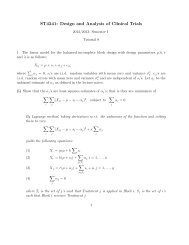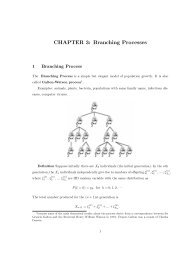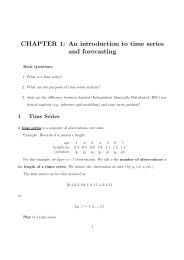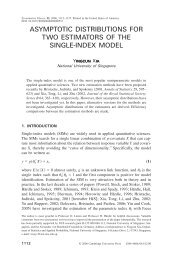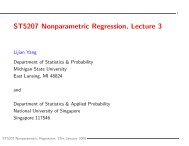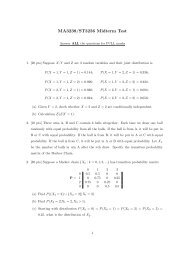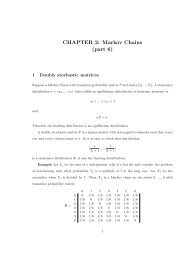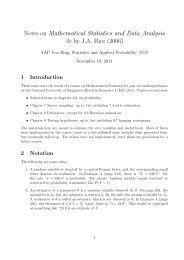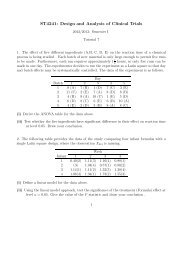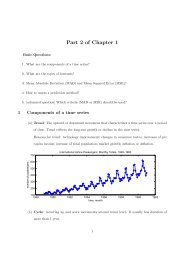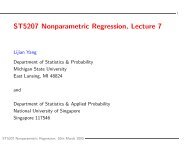ST3239: Survey Methodology - The Department of Statistics and ...
ST3239: Survey Methodology - The Department of Statistics and ...
ST3239: Survey Methodology - The Department of Statistics and ...
Create successful ePaper yourself
Turn your PDF publications into a flip-book with our unique Google optimized e-Paper software.
Chapter 2<br />
Simple r<strong>and</strong>om sampling<br />
Definition: If a sample <strong>of</strong> size n is drawn from a population <strong>of</strong> size N in such a way that every<br />
possible sample <strong>of</strong> size n has the same probability <strong>of</strong> being selected, the sampling procedure<br />
is called simple r<strong>and</strong>om sampling. <strong>The</strong> sample thus obtained is called a simple r<strong>and</strong>om<br />
sample. Simple r<strong>and</strong>om sampling is <strong>of</strong>ten written as s.r.s. for short <strong>and</strong> is the simplest<br />
sampling procedure.<br />
2.1 How to draw a simple r<strong>and</strong>om sample<br />
Suppose that the population <strong>of</strong> size N has values<br />
{u 1 , u 2 , · · · , u N }.<br />
If ( we ) draw n (distinct) items without replacement from the population, ( ) there are altogether<br />
N N<br />
different ways <strong>of</strong> doing it. So if we assign probability 1/ to each <strong>of</strong> the different<br />
n<br />
n<br />
samples, then each sample thus obtained is a simple r<strong>and</strong>om sample. We denote this sample<br />
by<br />
{y 1 , y 2 , · · · , y n }.<br />
Remark: In our previous statistics course, we always use upper-case letters like X, Y etc.<br />
to denote r<strong>and</strong>om variables <strong>and</strong> lower-case letters like x, y etc. to represent fixed values.<br />
However, in sample survey course, by convention, we use lower-case letters like y 1 , y 2 etc. to<br />
denote r<strong>and</strong>om variables.<br />
<strong>The</strong>orem 2.1.1 For simple r<strong>and</strong>om sampling, we have<br />
P (y 1 = u i1 , y 2 = u i2 , · · · , y n = u in ) = 1 N<br />
where i 1 , i 2 , · · · , i n are mutually different.<br />
1<br />
(N − 1) · · · 1<br />
(N − n + 1)<br />
(N − n)!<br />
= .<br />
N!<br />
3



